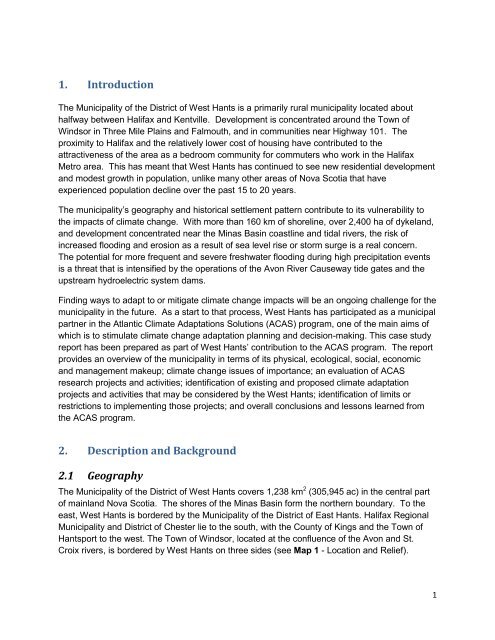Municipality Climate Adaptation Case Study Report
Municipality Climate Adaptation Case Study Report
Municipality Climate Adaptation Case Study Report
Create successful ePaper yourself
Turn your PDF publications into a flip-book with our unique Google optimized e-Paper software.
1. Introduction<br />
The <strong>Municipality</strong> of the District of West Hants is a primarily rural municipality located about<br />
halfway between Halifax and Kentville. Development is concentrated around the Town of<br />
Windsor in Three Mile Plains and Falmouth, and in communities near Highway 101. The<br />
proximity to Halifax and the relatively lower cost of housing have contributed to the<br />
attractiveness of the area as a bedroom community for commuters who work in the Halifax<br />
Metro area. This has meant that West Hants has continued to see new residential development<br />
and modest growth in population, unlike many other areas of Nova Scotia that have<br />
experienced population decline over the past 15 to 20 years.<br />
The municipality’s geography and historical settlement pattern contribute to its vulnerability to<br />
the impacts of climate change. With more than 160 km of shoreline, over 2,400 ha of dykeland,<br />
and development concentrated near the Minas Basin coastline and tidal rivers, the risk of<br />
increased flooding and erosion as a result of sea level rise or storm surge is a real concern.<br />
The potential for more frequent and severe freshwater flooding during high precipitation events<br />
is a threat that is intensified by the operations of the Avon River Causeway tide gates and the<br />
upstream hydroelectric system dams.<br />
Finding ways to adapt to or mitigate climate change impacts will be an ongoing challenge for the<br />
municipality in the future. As a start to that process, West Hants has participated as a municipal<br />
partner in the Atlantic <strong>Climate</strong> <strong>Adaptation</strong>s Solutions (ACAS) program, one of the main aims of<br />
which is to stimulate climate change adaptation planning and decision-making. This case study<br />
report has been prepared as part of West Hants’ contribution to the ACAS program. The report<br />
provides an overview of the municipality in terms of its physical, ecological, social, economic<br />
and management makeup; climate change issues of importance; an evaluation of ACAS<br />
research projects and activities; identification of existing and proposed climate adaptation<br />
projects and activities that may be considered by the West Hants; identification of limits or<br />
restrictions to implementing those projects; and overall conclusions and lessons learned from<br />
the ACAS program.<br />
2. Description and Background<br />
2.1 Geography<br />
The <strong>Municipality</strong> of the District of West Hants covers 1,238 km 2 (305,945 ac) in the central part<br />
of mainland Nova Scotia. The shores of the Minas Basin form the northern boundary. To the<br />
east, West Hants is bordered by the <strong>Municipality</strong> of the District of East Hants. Halifax Regional<br />
<strong>Municipality</strong> and District of Chester lie to the south, with the County of Kings and the Town of<br />
Hantsport to the west. The Town of Windsor, located at the confluence of the Avon and St.<br />
Croix rivers, is bordered by West Hants on three sides (see Map 1 - Location and Relief).<br />
1














